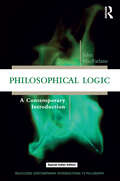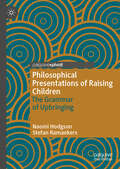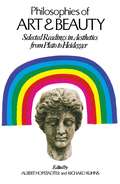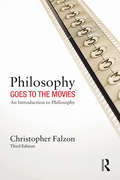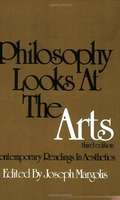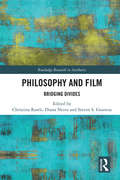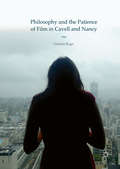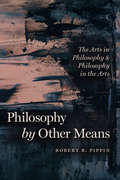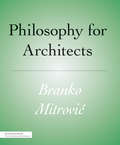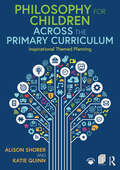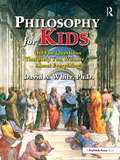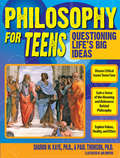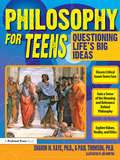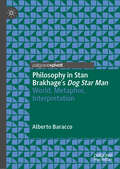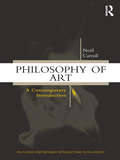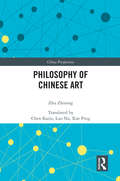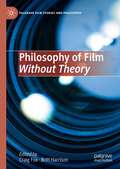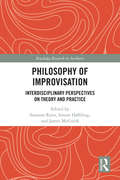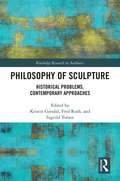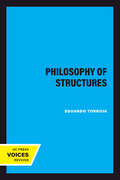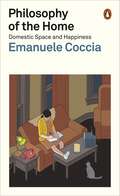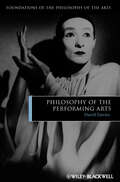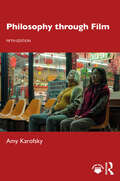- Table View
- List View
Philosophical Logic: A Contemporary Introduction (Routledge Contemporary Introductions to Philosophy)
by John MacFarlaneIntroductory logic is generally taught as a straightforward technical discipline. In this book, John MacFarlane helps the reader think about the limitations of, presuppositions of, and alternatives to classical first-order predicate logic, making this an ideal introduction to philosophical logic for any student who already has completed an introductory logic course.The book explores the following questions. Are there quantificational idioms that cannot be expressed with the familiar universal and existential quantifiers? How can logic be extended to capture modal notions like necessity and obligation? Does the material conditional adequately capture the meaning of 'if'—and if not, what are the alternatives? Should logical consequence be understood in terms of models or in terms of proofs? Can one intelligibly question the validity of basic logical principles like Modus Ponens or Double Negation Elimination? Is the fact that classical logic validates the inference from a contradiction to anything a flaw, and if so, how can logic be modified to repair it? How, exactly, is logic related to reasoning? Must classical logic be revised in order to be applied to vague language, and if so how? Each chapter is organized around suggested readings and includes exercises designed to deepen the reader's understanding.Key Features: An integrated treatment of the technical and philosophical issues comprising philosophical logic Designed to serve students taking only one course in logic beyond the introductory level Provides tools and concepts necessary to understand work in many areas of analytic philosophy Includes exercises, suggested readings, and suggestions for further exploration in each chapter
Philosophical Presentations of Raising Children: The Grammar of Upbringing
by Naomi Hodgson Stefan RamaekersThis book uses contemporary film to articulate a philosophical account of raising children. It forms part of a revaluation of the parent as a pedagogical figure, which stands in contrast to the instrumental accounts dominant in contemporary ‘parenting’ culture. Hodgson and Ramaekers use film in order to offer an affirmative account of the experience of raising children, as a presentation of those inevitable aspects and experiences that upbringing is: the initiation into language and the world; the representative nature of the parent; and the maintaining of mundane practices that constitute our shared culture and community. The films which are discussed are taken as grammatical investigations and enable the authors to develop an account of the use of film in education and as educational philosophy, and to respond to each film’s invitation to articulate the existential dimensions of raising children. Philosophical Presentations of Raising Children will be of interest to students and scholars across a range of disciplines, including education, sociology, philosophy, critical parenting studies and film studies.
Philosophies of Art and Beauty: Selected Readings in Aesthetics from Plato to Heidegger
by Albert Hofstadter Richard KuhnsThis anthology is remarkable not only for the selections themselves, among which the Schelling and the Heidegger essays were translated especially for this volume, but also for the editors' general introduction and the introductory essays for each selection, which make this volume an invaluable aid to the study of the powerful, recurrent ideas concerning art, beauty, critical method, and the nature of representation. Because this collection makes clear the ways in which the philosophy of art relates to and is part of general philosophical positions, it will be an essential sourcebook to students of philosophy, art history, and literary criticism.
Philosophy Goes to the Movies: An Introduction to Philosophy
by Christopher FalzonNow emulated in several competing publications, but still unsurpassed in clarity and insight, Philosophy Goes to the Movies: An Introduction to Philosophy, Third Edition builds on the approach that made the two earlier editions so successful. Drawing on many popular and some lesser known films from around the world, Christopher Falzon introduces students to key areas in philosophy, like: • Ethics • Social and Political Philosophy • The Theory of Knowledge • The Self and Personal Identity • Critical Thinking Perfect for beginners, this book guides the reader through philosophy using illuminating cinematic works, like Avatar, Inception, Fight Club, Wings of Desire, Run Lola Run, A Clockwork Orange, Blade Runner, Dirty Harry and many other films. The fully revised and updated Third Edition features: an expanded introduction that provides a new discussion of the relationship between film and philosophy; new material on notable philosophers such as Aristotle, Merleau-Ponty and Rawls; and coverage of new topics like virtue ethics and what Socrates offers for critical thinking. An updated glossary, references and bibliography, and a filmography, are also included in the Third Edition.
Philosophy Looks at the Arts: Contemporary Readings In Aesthetics
by Joseph MargolisThe first edition of this widely used anthology offered a needed introduction to a new analytic aesthetics which has in the intervening years become even more influential. This new, revised and expanded edition has been designed by one of the leaders of the field to help define the structure of current aesthetics. Of the 24 articles included more than half are new to this edition. The new edition emphasizes opposing currents in aesthetics with contributions from the most active and influential writers in the field. It is a basic book for any library and is designed to provide both undergraduate and graduate students with a professional orientation in aesthetics. Author note: Joseph Margolis is Professor of Philosophy at Temple University. He is the author or editor of twelve other books as well as numerous articles.
Philosophy and Film: Bridging Divides (Routledge Research in Aesthetics)
by Christina Rawls Diana Neiva Steven S. GouveiaThis volume collects twenty original essays on the philosophy of film. It uniquely brings together scholars working across a range of philosophical traditions and academic disciplines to broaden and advance debates on film and philosophy. The book includes contributions from a number of prominent philosophers of film including Noël Carroll, Chris Falzon, Deborah Knight, Paisley Livingston, Robert Sinnerbrink, Malcolm Turvey, and Thomas Wartenberg. While the topics explored by the contributors are diverse, there are a number of thematic threads that connect them. Overall, the book seeks to bridge analytic and continental approaches to philosophy of film in fruitful ways. Moving to the individual essays, the first two sections offer novel takes on the philosophical value and the nature of film. The next section focuses on the film-as-philosophy debate. Section IV covers cinematic experience, while Section V includes interpretations of individual films that touch on questions of artificial intelligence, race and film, and cinema’s biopolitical potential. Finally, the last section proposes new avenues for future research on the moving image beyond film. This book will appeal to a broad range of scholars working in film studies, theory, and philosophy.
Philosophy and the Patience of Film in Cavell and Nancy
by Daniele RugoPhilosophy and the Patience of Film presents a comparative study of the work of Jean-Luc Nancy and Stanley Cavell. It discusses the effect of their philosophical engagement with film, and proposes that the interaction between philosophy and film produces a power of patience capable of turning our negation of the world into a relation with it. Through detailed readings of cinematic works ranging from Hollywood classics to contemporary Iranian cinema, this book describes the interaction between film and philosophy as a productive friction from which the concept of patience emerges as a demand for thinking. Daniele Rugo explains how Nancy and Cavell's relationship with film demands the surrendering of philosophical mastery, and that it is precisely this act in view of the world that brings Cavell and Nancy to the study of film. While clarifying the nature of their engagement with film this book suggests that film does not represent the world, but 'realizes' it. This realization provides a scene of instruction for philosophy. Foreword by Jean-Luc Nancy, Distinguished Professor of Philosophy, Université Marc Bloch, Strasbourg.
Philosophy by Other Means: The Arts in Philosophy & Philosophy in the Arts
by Robert B. PippinThroughout his career, Robert B. Pippin has examined the relationship between philosophy and the arts. With his writings on film, literature, and visual modernism, he has shown that there are aesthetic objects that cannot be properly understood unless we acknowledge and reflect on the philosophical concerns that are integral to their meaning. His latest book, Philosophy by Other Means, extends this trajectory, offering a collection of essays that present profound considerations of philosophical issues in aesthetics alongside close readings of novels by Henry James, Marcel Proust, and J. M. Coetzee. The arts hold a range of values and ambitions, offering beauty, playfulness, and craftsmanship while deepening our mythologies and enriching the human experience. Some works take on philosophical ambitions, contributing to philosophy in ways that transcend the discipline’s traditional analytic and discursive forms. Pippin’s claim is twofold: criticism properly understood often requires a form of philosophical reflection, and philosophy is impoverished if it is not informed by critical attention to aesthetic objects. In the first part of the book, he examines how philosophers like Kant, Hegel, and Adorno have considered the relationship between art and philosophy. The second part of the book offers an exploration of how individual artworks might be considered forms of philosophical reflection. Pippin demonstrates the importance of practicing philosophical criticism and shows how the arts can provide key insights that are out of reach for philosophy, at least as traditionally understood.
Philosophy for Architects
by Branko MitrovicPhilosophy for Architects is an engaging and easy-to-grasp introduction to philosophical questions of interest to students of architectural theory. Topics include Aristotle's theories of "visual imagination" and their relevance to digital design, the problem of optical correction as explored by Plato, Hegel's theory of zeitgeist, and Kant's examinations of space and aesthetics, among others. Focusing primarily on nineteenth- and twentieth-century philosophy, it provides students with a wider perspective concerning philosophical problems that come up in contemporary architectural debates.
Philosophy for Children Across the Primary Curriculum: Inspirational Themed Planning
by Katie Quinn Alison ShorerThis is an easy-to-use, theme-based resource book for Philosophy for Children (P4C) practitioners in primary school settings. It covers ten popular themes which include many current affair issues and enduring curriculum themes such as artificial intelligence, biodiversity, resilience, and waste. Each theme provides planning for every subject and links to the relevant English national curriculum expectations. Offering ideas for a year’s worth of work, it can be dipped into for inspiration or used for step-by-step sessions. There are links to video clips, websites, and stories that teachers and practitioners can use to base their concept exploration and enquires on. Presenting a range of philosophical ideas, activities, and resources, this book is essential for all primary P4C facilitators excited by embedding and exploring philosophy across the curriculum.
Philosophy for Children Across the Primary Curriculum: Inspirational Themed Planning
by Katie Quinn Alison ShorerThis is an easy-to-use, theme-based resource book for Philosophy for Children (P4C) practitioners in primary school settings. It covers ten popular themes which include many current affair issues and enduring curriculum themes such as artificial intelligence, biodiversity, resilience, and waste.Each theme provides planning for every subject and links to the relevant English national curriculum expectations. Offering ideas for a year’s worth of work, it can be dipped into for inspiration or used for step-by-step sessions. There are links to video clips, websites, and stories that teachers and practitioners can use to base their concept exploration and enquires on.Presenting a range of philosophical ideas, activities, and resources, this book is essential for all primary P4C facilitators excited by embedding and exploring philosophy across the curriculum.
Philosophy for Kids: 40 Fun Questions That Help You Wonder About Everything!
by David A. WhiteInspire animated discussions of questions that concern kids—and all of us—with this innovative, interactive book. Open your students' minds to the wonders of philosophy.Allow them to grapple with the questions philosophers have discussed since the ancient Greeks. Questions include: “Who are your friends?,” “Can computers think?,” “Can something logical not make sense?,” and “Can you think about nothing?” Young minds will find these questions to be both entertaining and informative. If you have ever wondered about questions like these, you are well on your way to becoming a philosopher!Philosophy for Kids offers young people the opportunity to become acquainted with the wonders of philosophy. Packed with exciting activities arranged around the topics of values, knowledge, reality, and critical thinking, this book can be used individually or by the whole class. Each activity allows kids to increase their understanding of philosophical concepts and issues and enjoy themselves at the same time. In addition to learning about a challenging subject, students philosophizing in a classroom setting, as well as the casual reader of Philosophy for Kids, will sharpen their ability to think critically about these and similar questions. Experiencing the enjoyment of philosophical thought enhances a young person's appreciation for the importance of reasoning throughout the traditional curriculum of subjects. The book includes activities, teaching tips, a glossary of terms, and suggestions for further reading.Grades 4-12
Philosophy for Teens: Questioning Life's Big Ideas
by Sharon M. Kaye Paul ThomsonWhat is love? Is lying always wrong? Is beauty a matter of fact, or a matter of taste? What is discrimination? The answers to these questions, and more, are examined in Philosophy for Teens: Questioning Life's Big Ideas, an in-depth, teenager-friendly look at the philosophy behind everyday issues. The authors examine some of life's biggest topics, such as lying, cheating, love, beauty, the role of government, hate, and prejudice. Both sides of the debates are covered on every issue, with information from some of the world's most noted philosophers included in a conversational style that teenagers will love. Each chapter includes discussions questions, thought experiments, exercises and activities, and community action steps to help students make reasoned, informed decisions about some of life's greatest debates.
Philosophy for Teens: Questioning Life's Big Ideas (Grades 7-12)
by Sharon M. Kaye Paul ThomsonWhat is love? Is lying always wrong? Is beauty a matter of fact, or a matter of taste? What is discrimination?The answers to these questions, and more, are examined in Philosophy for Teens: Questioning Life's Big Ideas, an in-depth, teenager-friendly look at the philosophy behind everyday issues. The authors examine some of life's biggest topics, such as:lying,cheating,love,beauty,the role of government,hate, andprejudice.Both sides of the debates are covered on every issue, with information from some of the world's most noted philosophers included in a conversational style that teenagers will love. Each chapter includes discussions questions, thought experiments, exercises and activities, and community action steps to help students make reasoned, informed decisions about some of life's greatest debates.Examining life's big ideas and discovering their own opinions have never been easier or more exciting for today's teens.Grades 7-12
Philosophy in Stan Brakhage's Dog Star Man: World, Metaphor, Interpretation
by Alberto BaraccoThis book shows how a masterpiece of experimental cinema can be interpreted through hermeneutics of the film world. As an application of Ricœurian methodology to a non-narrative film, the book calls into question the fundamental concept of the film world. Firmly rooted within the context of experimental cinema, Stan Brakhage’s Dog Star Man was not created on the basis of a narrative structure and representation of characters, places and events, but on very different presuppositions. The techniques with which Brakhage worked on celluloid and used frames as canvases, as well as his choice to make the film without dialogue and sound, exhort the interpreter to directly question the philosophical language of moving images.
Philosophy of Art: A Contemporary Introduction (Routledge Contemporary Introductions to Philosophy)
by Noël CarrollPhilosophy of Art is a textbook for undergraduate students interested in the topic of philosophical aesthetics.It introduces the techniques of analytic philosophy as well as key topics such as the representational theory of art, formalism, neo-formalism, aesthetic theories of art, neo-Wittgensteinism, the Institutional Theory of Art. as well as historical approaches to the nature of art.Throughout, abstract philosophical theories are illustrated by examples of both traditional and contemporary art including frequent reference to the avant-garde in this way enriching the readers understanding of art theory as well as the appreciation of art.Unique features of the textbook are:* chapter summaries* summaries of major theories of art and suggested analyses of the important categories used when talking and thinking of art* annotated suggested readings at the ends of chapters.
Philosophy of Chinese Art (China Perspectives)
by Zhu ZhirongThis title provides a systematic examination of the philosophy of Chinese art, exploring the peculiarity of artistic forms and distinctive conceptions and artistic principles of Chinese art which are grounded in the life awareness of the ancient Chinese and interconnect with the Chinese philosophy of life.Synthesizing Chinese theories of art with Western philosophical systems, the book is organized into five parts: (1) the subject, the actor who creates, appreciates, and criticizes artistic works; (2) ontological aspects, that is, the artwork per se and the dynamic process of creation; (3) aesthetic traits, the organic whole constituted by rhythm, meter, the principle of harmony, and space-time awareness; (4) artistic representation, which is manifested in the rhythm of vital energy, momentum of genre, vigour of style, and taste and inclination; and (5) the evolution of Chinese art. Based on this structural thread, the author looks into the interwoven relationship between the philosophy of Chinese art and ancient Chinese thought in terms of the spirit of life, nature–human relations, and ontological awareness of human-centredness.The book will appeal to scholars, students, and general readers interested in aesthetics, art theory, art philosophy, Chinese art, and ancient Chinese culture.
Philosophy of Film Without Theory (Palgrave Film Studies and Philosophy)
by Craig Fox Britt HarrisonThis book challenges the long-standing presumption that serious philosophical engagement with film and television must be theoretical. It demonstrates, by example, how philosophy of film and film studies can move beyond the methodological assumption that understands philosophical to mean theoretical. In seventeen specially commissioned essays, one in-depth interview, and one reprint, leading philosophers and film scholars exploit the approaches, arguments, and insights of Ludwig Wittgenstein, Stanley Cavell, Iris Murdoch, Augustine, Berys Gaut, Noël Carroll, and Ordinary Language Philosophy, in exploring, amongst others, Gravity, Lone Star, The Handmaid’s Tale, Le notti di Cabiria, Dunkirk, L'Année dernière à Marienbad, Visitors, The Night it Rained, Philadelphia Story, Shoah, Mary Magdalene, Psycho, Blue Jasmine, Three Colours: Red, War Games, and Histoire(s) du Cinéma. In so doing, this collection argues for the power of theory-free philosophy and film studies as a way to expand our humanistic understanding.
Philosophy of Improvisation: Interdisciplinary Perspectives on Theory and Practice (Routledge Research in Aesthetics)
by Susanne Ravn; Simon Høffding; James McGuirkThis volume brings together philosophical and interdisciplinary perspectives on improvisation. The contributions connect the theoretical dimensions of improvisation with different viewpoints on its practice in the arts and the classroom. The chapters address the phenomenon of improvisation in two related ways. On the one hand, they attend to the lived practices of improvisation both within and without the arts in order to explain the phenomenon. They also extend the scope of improvisational practices to include the role of improvisation in habit and in planned action, at both individual and collective levels. Drawing on recent work done in the philosophy of mind, they address questions such as whether improvisation is a single unified phenomenon or whether it entails different senses that can be discerned theoretically and practically. Finally, they ask after the special kind of improvisational expertise which characterizes musicians, dancers, and other practitioners, an expertise marked by the artist’s ability to participate competently in complex situations while deliberately relinquishing control. Philosophy of Improvisation will appeal to anyone with a strong interest in improvisation, to researchers working in philosophy, aesthetics, and pedagogy as well as practitioners involved in different kinds of music, dance, and theater performances.
Philosophy of Improvisation: Interdisciplinary Perspectives on Theory and Practice (Routledge Research in Aesthetics)
by Susanne Ravn; Simon Høffding; James McGuirkThis volume brings together philosophical and interdisciplinary perspectives on improvisation. The contributions connect the theoretical dimensions of improvisation with different viewpoints on its practice in the arts and the classroom. The chapters address the phenomenon of improvisation in two related ways. On the one hand, they attend to the lived practices of improvisation both within and without the arts in order to explain the phenomenon. They also extend the scope of improvisational practices to include the role of improvisation in habit and in planned action, at both individual and collective levels. Drawing on recent work done in the philosophy of mind, they address questions such as whether improvisation is a single unified phenomenon or whether it entails different senses that can be discerned theoretically and practically. Finally, they ask after the special kind of improvisational expertise which characterizes musicians, dancers, and other practitioners, an expertise marked by the artist’s ability to participate competently in complex situations while deliberately relinquishing control. Philosophy of Improvisation will appeal to anyone with a strong interest in improvisation, to researchers working in philosophy, aesthetics, and pedagogy as well as practitioners involved in different kinds of music, dance, and theater performances.
Philosophy of Sculpture: Historical Problems, Contemporary Approaches (Routledge Research in Aesthetics)
by Kristin GjesdalSculpture has been a central aspect of almost every art culture, contemporary or historical. This volume comprises thirteen essays at the cutting edge of thinking about sculpture in philosophical terms, representing approaches to sculpture from the perspectives of both Anglo-American and European philosophy. Some of the essays are historically situated, while others are more straightforwardly conceptual. All of the essays, however, pay strict attention to actual sculptural examples in their discussions. This reflects the overall aim of the volume to not merely "apply" philosophy to sculpture, but rather to test the philosophical approaches taken in tandem with deep analyses of sculptural examples. There is an array of philosophical problems unique to sculpture, namely certain aspects of its three-dimensionality, physicality, temporality, and morality. The authors in this volume respond to a number of challenging philosophical questions related to these characteristics. Furthermore, while the focus of most of the essays is on Western sculptural traditions, there are contributions that features discussion of sculptural examples from non-Western and archaic sources. Philosophy of Sculpture is the first full-length book treatment of the philosophical significance of sculpture in English. It is a valuable resource for advanced students and scholars across aesthetics, art history, history, performance studies, and visual studies.
Philosophy of Structures
by Eduardo TorrojaThis title is part of UC Press's Voices Revived program, which commemorates University of California Press’s mission to seek out and cultivate the brightest minds and give them voice, reach, and impact. Drawing on a backlist dating to 1893, Voices Revived makes high-quality, peer-reviewed scholarship accessible once again using print-on-demand technology. This title was originally published in 1958.This title is part of UC Press's Voices Revived program, which commemorates University of California Press’s mission to seek out and cultivate the brightest minds and give them voice, reach, and impact. Drawing on a backlist dating to 1893, Voices Revived</DIV
Philosophy of the Home: Domestic Space and Happiness
by Emanuele CocciaA bedroom, a kitchen, a bathroom - are these rooms all that make a home? Not at all, argues Emanuele Coccia. The buildings we inhabit are of immense psychological and cultural significance. They play a decisive role in human flourishing and, for hundreds of years, their walls and walkways, windows and doorways have guided our relationships with others and with ourselves. They reflect and reinforce social inequalities; they allow us to celebrate and cherish those we love. They are the places of return that allow us to venture out into the world.In this intimate, elegantly argued account, Coccia shows how the architecture of home has shaped, and continues to shape, our psyches and our societies, before then masterfully leading us towards a more creative, ecological way of dwelling in the world.
Philosophy of the Performing Arts (Foundations of the Philosophy of the Arts #3)
by David DaviesThis book provides an accessible yet sophisticated introduction to the significant philosophical issues concerning the performing arts. Presents the significant philosophical issues concerning the performing arts in an accessible style, assuming no prior knowledge Provides a critical overview and a comprehensive framework for thinking about the performing arts Examines the assumption that classical music provides the best model for thinking about artistic performance across the performing arts Explores ways in which the ‘classical paradigm’ might be extended to other musical genres, to theatre, and to dance Applies the thinking on performing arts to the issue of ‘performance art’
Philosophy through Film
by Amy KarofskyThis fifth edition of Philosophy through Film uses recently released, well-received movies to explore answers to classic questions in philosophy in an approachable yet philosophically rigorous manner. Author Amy Karofsky uses two films in each chapter to examine one long-standing philosophical question and assess some of the best solutions to it that have been offered. The chosen movies are not mere “add-ons” to an otherwise straightforward introductory text; instead, they are fully integrated into the discussion of the issues and the various positions. Each chapter also includes discussion questions, an annotated list of films related to the chapter topic, and two or three historically significant primary sources (which are collected together at the end of the book).Changes to the fifth edition include: The replacement of older movies with four new focus films: Anatomy of a Fall, Everything Everywhere All at Once, Get Out, and The Time Traveler’s Wife. The addition of new primary readings from Roderick Chisholm, Jerry Fodor, Baron d’Holbach, and Susan Wolf. Important new sections added to Chapter 1 on Truth (“The Identity Theory of Truth”) and Chapter 5 on Artificial Intelligence (“The I in AI”). A major overhaul of Chapter 6 on free will, determinism, and moral responsibility. Updated notes throughout. The films examined in depth are: Ad Astra; Anatomy of a Fall; Arrival; Beautiful Boy; Crimes and Misdemeanors; Divergent; Equilibrium, Everywhere Everything All at Once; Ex Machina; Get Out; Gone Baby Gone; Her; Inception; Edge of Tomorrow; The Matrix; Memento; A Serious Man; Silence; The Time Traveler’s Wife.For a collection of Story Lines of the Discussed Films by Elapsed Time, visit: www.routledge.com/9781032544595
